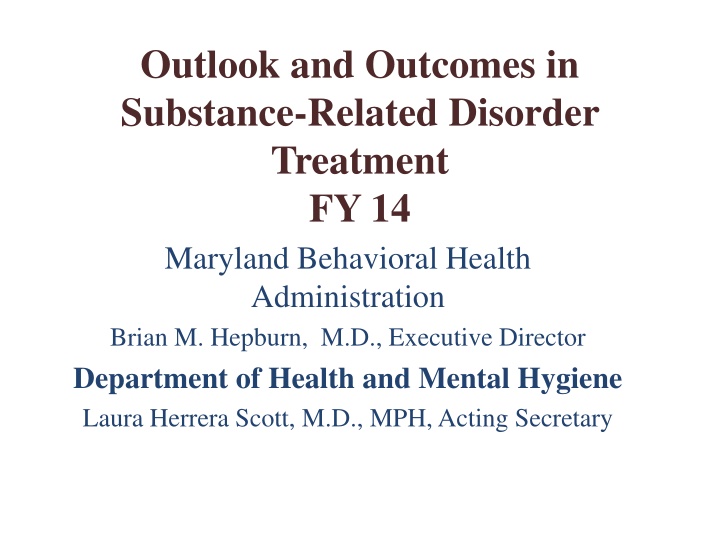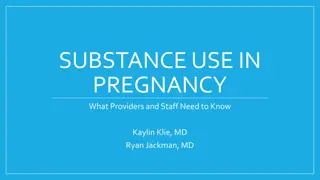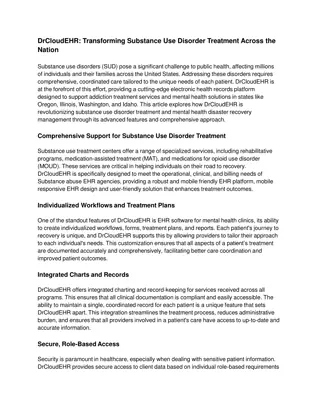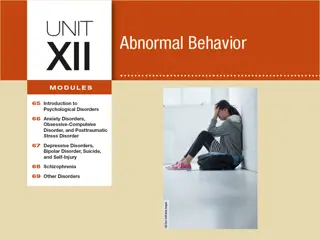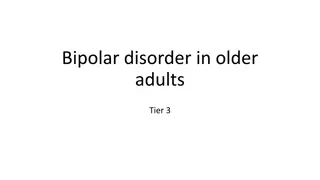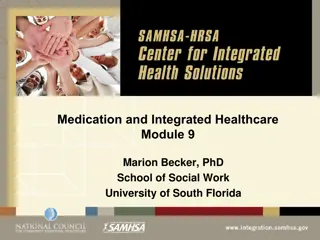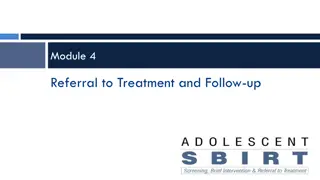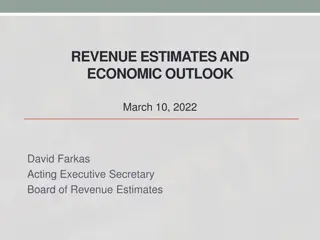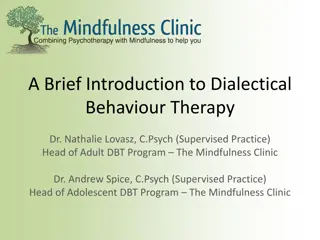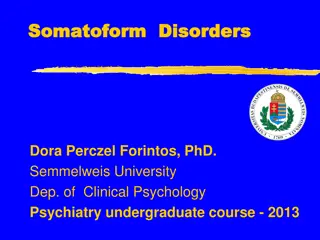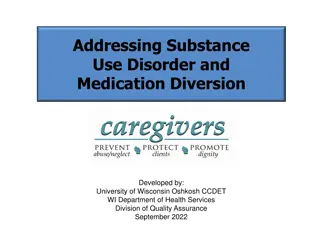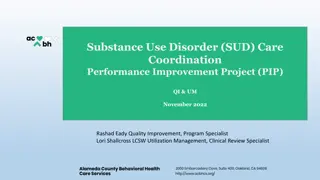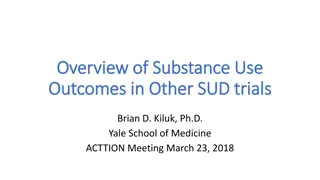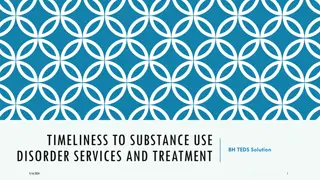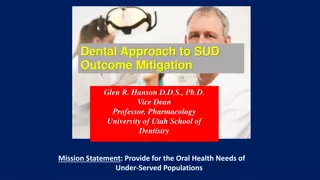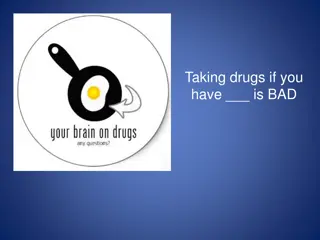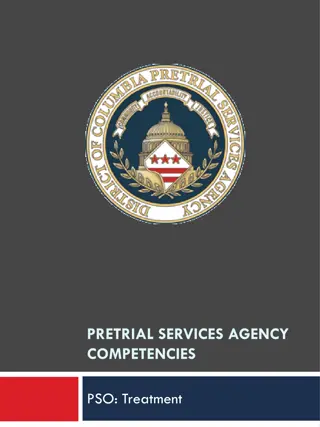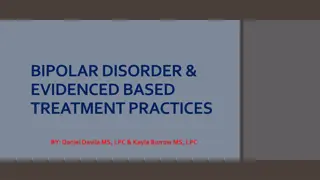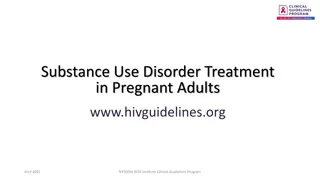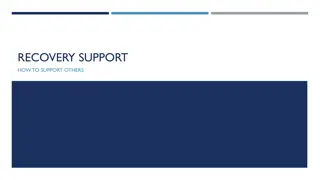Outlook and Outcomes in Substance-Related Disorder Treatment FY 14 Maryland
This report details data on primary patient admissions and discharges from substance-related disorder treatment programs in Maryland for FY 2014. The information is based on reporting to the Statewide Maryland Automated Record Tracking system. It highlights trends in admissions, enrollments, and prior treatment experiences over six years. The report indicates a decline in reporting to SMART in FY 2013 and FY 14, with insights into referrals from criminal justice agencies and statewide arrests. Figures illustrate the number of individuals, admissions, and enrollments in state-supported programs.
Download Presentation

Please find below an Image/Link to download the presentation.
The content on the website is provided AS IS for your information and personal use only. It may not be sold, licensed, or shared on other websites without obtaining consent from the author.If you encounter any issues during the download, it is possible that the publisher has removed the file from their server.
You are allowed to download the files provided on this website for personal or commercial use, subject to the condition that they are used lawfully. All files are the property of their respective owners.
The content on the website is provided AS IS for your information and personal use only. It may not be sold, licensed, or shared on other websites without obtaining consent from the author.
E N D
Presentation Transcript
Outlook and Outcomes in Substance-Related Disorder Treatment FY 14 Maryland Behavioral Health Administration Brian M. Hepburn, M.D., Executive Director Department of Health and Mental Hygiene Laura Herrera Scott, M.D., MPH, Acting Secretary
The data in this report reflect primary-patient admissions to and discharges from programs receiving state funding, reported to the Statewide Maryland Automated Record Tracking (SMART) system, a Web-based tool that provides consent- driven patient-tracking. Programs receiving any public funds were required to report data on all their patients regardless of source of payment for individual patients. This summary of reporting over six years represents the final such report based on SMART reporting. Effective January 1, 2015 data-reporting by substance-related disorder (SRD) treatment programs was directed to an Administrative Service Organization.
Admissions represent the initiation of treatment episodes within individual programs. Enrollments reflect patient transfers to different levels of care within episodes. Levels of Care are defined later in this report. On average in FY 14 individual patients experienced 1.26 admissions and 1.55 enrollments. With the impending transition to a new reporting system in CY 2015, reporting to SMART declined by 5 percent in FY 2013 and 10 percent in FY 14, as shown in Figures 1 and 2. As will be shown later in this report, a reduction in referrals from criminal-justice agencies, associated with declining statewide arrests for DUI and drug possession and sales, was also a factor. Figure 2 shows the number of admissions with previous treatment experience has been stable at about 65 percent of the total over the six years.
Figure 1 Individuals, Admissions and Enrollments in State-Supported Substance-Related Disorder Treatment Programs Reporting Data FY 2009 to FY 2014 60,000 56,179 56,027 53,877 53,238 50,000 49,797 48,402 45,524 45,805 43,524 43,954 40,000 41,612 39,318 56,179 56,027 30,000 53,877 53,238 49,797 Individuals Admissions Enrollments 48,402 45,805 45,524 43,954 43,524 41,612 39,318 20,000 36,307 36,100 35,204 34,161 33,906 31,302 10,000 0 FY 2009 FY 2010 FY 2011 FY 2012 FY 2013 FY 2014
Figure 2 Prior Admission to State-Supported Substance-Related Disorder Treatment Programs Reporting Data FY 2009 to FY 2014 First Admission Prior Admission(s) 50,000 40,000 29,182 30,119 29,184 28,542 30,000 27,138 25,629 20,000 10,000 16,342 15,686 14,992 14,770 14,474 13,689 0 2009 2010 2011 2012 2013 2014 Fiscal Year
As the reduction in volume of admissions is largely a reporting artifact, it will be most informative to examine trends in percentages over the past six fiscal years. Age at Admission Figure 3 shows relatively little variation in the distribution of age of admissions over the six years, although there is a steady increase of nearly 20 percent in admissions in the 26 to 30 age category and an increase of a third in admissions over age 50. The percent of admissions involving adolescents fell by 16 percent in the last four years.
Figure 2 Age at Admission to State-Supported Substance-Related Disorder Treatment Programs Reporting Data FY 2009 to FY 2014 100.0% 10.1 10.6 11.4 12.0 12.7 13.5 80.0% 24.9 24.1 22.7 22.4 21.3 20.7 Under 18 18 to 25 26 to 30 31 to 40 41 to 50 Over 50 60.0% 18.5 18.7 18.4 19.2 19.4 20.8 13.2 13.3 14.3 12.9 14.6 12.2 40.0% 23.8 23.7 23.7 23.7 22.4 23.4 20.0% 10.3 10.1 9.5 9.5 9.3 8.6 0.0% FY 2009 FY 2010 FY 2011 FY 2012 FY 2013 FY 2014
Race and Gender The race and gender breakdown of admissions is shown in Figure 4. While the percentage of white female admissions increased by 13 percent in six years, admissions involving black females fell by 11 percent. The percentage of white male admissions increased slightly and black male admissions declined by 7 percent. As will be shown later in this report, dramatic increases in heroin problems among white admissions is correlated with this racial transition. Both males and females of other races increased significantly in percentage, largely reflecting greater access to services by Hispanics.
Figure 4 Race/Gender among Admissions to State-Supported Substance-Related Disorder Treatment Programs Reporting Data FY 2009 to FY 2014 1.3 1.3 1.4 1.6 1.7 1.7 100.0% 3.9 3.9 3.8 4.2 4.7 4.8 12.1 12.2 13.1 12.0 11.7 12.0 80.0% 29.8 29.5 30.7 29.5 29.3 31.7 60.0% 18.9 18.0 20.0 19.6 19.9 17.6 40.0% White Males Black Males Other Males White Females Black Females Other Females 20.0% 34.1 33.8 32.7 32.6 32.5 32.4 0.0% FY 2009 FY 2010 FY 2011 FY 2012 FY 2013 FY 2014
Employment Status Figure 5 displays the distributions of adult admissions by employment status. While the total percentage unemployed from FY 09 to 14 was fairly stable at about 73 percent, there was a 22 percent shift away from out-of-the- workforce categories toward the percentage of patients presumably seeking work. The exception was the Disabled category, which jumped by 39 percent. Full-time employment fell by 10 percent while part-time employment advanced by 14.
Figure 5 Employment Status at Admission to State-Supported Substance-Related Disorder Treatment Programs Reporting Data FY 2009 to FY 2014 100.0% 41.3 80.0% 45.8 42.8 47.8 50.5 50.6 60.0% 18.6 11.2 16.2 13.5 9.0 9.7 40.0% 4.8 4.2 6.7 4.6 4.7 5.6 8.8 9.4 6.7 8.8 8.0 6.7 5.8 6.2 6.6 5.7 5.7 6.3 20.0% 18.8 16.4 17.4 17.4 17.0 16.5 0.0% FY 2009 FY 2010 FY 2011 FY 2012 FY 2013 FY 2014 Full-Time Part-Time Disabled Incarcerated Other Out-of-Workforce Other Unemployed
Marital Status & Dependent Children Nearly seventy percent of FY 14 adult admissions had never been married and 13 percent were married or in a common-law relationship, as shown in Figure 6. Forty-three percent of the admissions to treatment in FY 14 reported having one or more dependent children. The 21,299 unduplicated adult males admitted during FY 14 reported a total of 15,213 dependent children, while the 9,437 individual females reported 10,239 dependent children. Of the 11,311 females of child-bearing age admitted during FY 14, 523 were reported pregnant at admission.
Figure 6 Marital Status and Number of Dependent Children among Adult Admissions to State-Supported Substance-Related Disorder Treatment Programs Reporting Data FY 2014 Never Married None 68.1% 56.8% 19.7% One 12.6% 1.9% 12.6% 5.9% 6.2%4.7% 11.6% Married Widowed Two Separated Four or More Divorced Three Marital Status Number of Dependent Children
Patient Residence Admissions are distributed by percentage location of residence from FY 09 to FY 14 in Table 1. The largest five-year increases in percentages involved residents of Cecil, Harford, Howard, Dorchester and Calvert counties. Excluding St. Mary s, which had particularly significant reporting issues, the largest declines were in Garrett, Kent and Montgomery counties. Out-of-State residents, primarily from Delaware, Washington, D. C. and Virginia, decreased by 17 percent.
Table 1 Patient Residence Percentages for Admissions to State-Supported Substance-Related Disorder Treatment Programs Reporting Data FY 2009 to FY 2014 Residence FY 2009 FY 2010 FY 2011 FY 2012 FY 2013 FY 2014 Allegany Anne Arundel Baltimore City Baltimore County Calvert Caroline Carroll Cecil Charles Dorchester Frederick Garrett Harford Howard Kent Montgomery Prince George's Queen Anne's St. Mary's Somerset Talbot Washington Wicomico Worcester Out-of-State Total 2.0 7.3 30.1 9.3 2.8 1.1 2.2 1.9 2.9 1.4 3.0 0.9 2.1 1.7 0.9 6.7 6.0 1.6 2.3 0.9 1.2 3.0 3.0 1.8 3.6 100.0 1.9 7.6 29.2 9.9 3.3 1.1 2.6 1.8 2.7 1.5 3.3 0.8 2.5 2.0 0.8 5.8 5.8 1.8 2.6 0.8 1.2 2.9 2.9 1.8 3.4 100.0 1.6 8.3 29.6 10.3 3.5 1.0 2.8 2.4 2.4 1.6 3.1 0.8 2.9 2.1 0.8 5.4 5.0 1.3 2.7 0.7 1.1 2.6 3.4 1.7 2.9 100.0 1.5 9.2 30.6 10.6 3.4 1.0 2.0 3.0 2.4 1.5 2.8 0.8 3.0 2.0 0.6 5.2 4.5 1.6 2.4 0.8 0.9 2.5 3.2 1.8 2.6 100.0 1.5 8.8 30.3 10.4 3.5 0.9 1.9 2.9 2.5 1.5 2.8 0.7 3.1 2.0 0.6 5.4 5.8 1.6 2.1 0.7 1.0 2.2 3.6 1.6 2.4 100.0 1.7 8.5 29.3 10.3 3.4 1.2 2.4 3.2 2.6 1.7 3.0 0.6 3.6 2.1 0.7 5.2 6.1 1.5 0.9 0.7 1.2 2.5 3.0 1.6 2.9 100.0
Educational Status The educational attainment of adolescent and adult admissions is shown in Figure 7. Nine out of ten adolescents were attending school. Only about 64 percent of adult FY 14 treatment admissions had high-school diplomas. Seven percent of adolescents and nearly a third of adults admitted could be classified as high- school drop-outs.
Figure 7 Educational Attainment among Adolescent and Adult Admissions to State-Supported Substance-Related Disorder Treatment Programs Reporting Data FY 2014 Some College College Grad In K thru 12 In K thru 12 19.1% 3.3% 90.4% 4.1% 32.2% HS Drop-Out 2.5% 41.3% 7.0% 0.1% HS Grad HS Grad HS Drop-Out Some College Adolescents N = 3,378 Adults N = 35,769
Health Coverage Health coverage of admissions is shown in Figure 8.The reported coverage does not necessarily reflect payment for the immediate treatment episode. Admissions involving patients with no health coverage decreased steadily from 60 percent in FY 08 to just over one-fourth in FY 14, while the percentage with Medicaid nearly tripled. Admissions with private insurance were relatively stable.
Figure 8 Health-Care Coverage among Admissions to State-Supported Substance-Related Disorder Treatment Programs Reporting Data FY 2009 to FY 2014 3.3 3.6 4.4 100.0% 5.2 5.5 5.6 12.3 13.8 11.1 14.0 11.7 12.6 5.0 4.2 4.1 4.6 6.1 4.2 2.9 80.0% 3.6 4.8 3.2 3.2 2.8 16.9 27.0 60.0% 35.8 40.7 43.4 48.6 None Medicare Managed Private Medicaid Other Public Non-Managed Private 40.0% 59.5 46.7 38.4 20.0% 33.7 31.7 25.8 0.0% FY 2009 FY 2010 FY 2011 FY 2012 FY 2013 FY 2014
Source of Referral Figure 9 shows about a third of FY 14 admissions were self or family referrals, up from 25 percent in FY 09. Criminal-justice sources accounted for 36 percent of admissions in FY 14, a 20 percent reduction from FY 09. As most criminal-justice referrals originate in arrests, a 6 percent reduction in arrests for drug sales and possession from 2009 to 2013 (15 percent since 2008) and a 12 percent decline in arrests for Driving Under the Influence help explain the declining referrals. Arrest data were drawn from Maryland State Police Crime in Maryland reports.
Figure 9 Source of Referral among Admissions to State-Supported Substance-Related Disorder Treatment Programs Reporting Data FY 2009 to FY 2014 100.0% 11.2 11.6 11.7 12.5 13.1 13.2 8.1 7.1 8.5 8.5 7.5 7.7 80.0% 11.2 11.8 9.7 10.9 10.2 11.5 60.0% 24.7 26.1 27.3 31.0 32.7 32.7 45.2* 42.8* 40.3* 38.1* 7.7 37.0* 36.1* 40.0% 8.9 8.9 8.6 7.6 7.9 7.5 6.8 5.8 5.8 5.3 5.1 15.9 14.0 13.4 20.0% 12.5 13.1 13.6 6.9 6.7 6.0 5.7 4.9 5.4 5.4 5.0 5.0 4.6 4.4 3.5 0.0% FY 2009 FY 2010 FY 2011 FY 2012 FY 2013 FY 2014 Juvenile Justice Drug Court SRD Provider DWI/DUI Other Criminal Justice Other Healthcare Probation/Parole Self/Family/Friends Other *Total Criminal Justice Percentage
ASAM Levels The following two slides present definitions of ASAM levels. Table 2 presents the distributions of state-supported admissions and enrollments by level of care over the past six years. Admissions reflect the initial enrollments in treatment episodes; subsequent enrollments during the episodes (transfers to other levels of care) are not counted as admissions. The overall ratio of enrollments to admissions was about 1.23 for the last four years. Not surprisingly the highest enrollment/admission ratios were in levels of care to which patients are typically transferred or referred from more intensive levels. Consistently just over two-thirds of admissions entered ambulatory levels of care.
Defining Treatment Levels of Care Early Intervention (0.5) Outpatient counseling for individuals who do not meet criteria for a substance use disorder, but who are at high risk for alcohol or other drug problems (e.g., DUI patients, school based early intervention). Level I - Outpatient Treatment (I) Nonresidential, structured treatment services for less than nine hours a week per patient. Examples include office practice, health clinics, primary care clinics, mental health clinics, and step down programs that provide individual, group and family counseling services. Detoxification services are delivered in Level I.D. Opioid Maintenance Therapy (I-OTP) Medication assisted treatment specific to opioid addiction. Patients are medically supervised and engaged in structured clinical protocols. Services are delivered under a defined set of policies, procedures and medical protocols. Methadone maintenance programs are an example of this level of care. Detoxification services are delivered in Level OMT.D. Level II - Intensive Outpatient (II.1) A structured therapeutic milieu in an outpatient setting that delivers nine or more hours of structured treatment services per patient, per week. Partial Hospitalization (II.5) - Provides each patient with 20 or more hours of clinically intensive programming per week based on individual treatment plans. Programs have pre-defined access to psychiatric, medical and laboratory services. Detoxification services are delivered in Level II.D.
Partial Hospitalization (II.5) - Provides each patient with 20 or more hours of clinically intensive programming per week based on individual treatment plans. Programs have pre-defined access to psychiatric, medical and laboratory services. Detoxification services are delivered in Level II.D. Level III - Clinically Managed Low Intensity Residential Treatment (III.1) - Provides Level I treatment services to patients in a residential setting such as a halfway house. Clinically Managed Medium Intensity Residential Treatment (III.3)- Programs provide a structured recovery environment in combination with clinical services. For example, a therapeutic rehabilitation facility offering long-term care. Clinically Managed High Intensity Residential Treatment (III.5)- A structured therapeutic community providing a recovery environment in combination with intense clinical services, such as a residential treatment center. Medically-Monitored Intensive Inpatient Treatment (III.7)- Programs offering a planned regimen of 24 hour professionally directed evaluation, care and treatment for addicted patients in an inpatient setting, Level III.7 care is delivered by an interdisciplinary staff to patients whose sub-acute biomedical and emotional/behavioral problems are sufficiently severe to require inpatient care. Detoxification services are delivered in Level III.7.D. Source: ASAM Patient Placement Criteria for the Treatment of Substance-Related Disorders, (Second Edition - Revised ): (ASAM PPC-2R) April, 2001.
Table 2 Admissions and Enrollments by ASAM Level of Care in State-Supported Substance-Related Disorder Treatment Programs Reporting Data FY 2009 to FY 2014 FY 2009 FY 2010 FY 2011 FY 2012 FY 2013 FY 2014 ASAM Level of Care Adm Enr Adm Enr Adm Enr Adm Enr Adm Enr Adm Enr Level 0.5 687 703 1027 1069 2131 2207 1859 1945 1764 1882 1834 1934 Level I 17338 20525 17310 20605 17252 21278 16411 20299 15830 19721 14261 17620 Level I.D 323 414 225 278 45 49 65 75 91 115 29 33 Level II.1 7045 8317 7126 8441 7837 9483 8231 9888 7944 9737 6647 8392 Level II.5 444 1071 792 1517 971 1797 837 1692 1063 1868 1536 2265 Level II.D 89 99 102 120 105 126 53 62 33 34 12 16 Level III.1 1687 1765 1539 1678 1364 1519 1217 1368 1005 1203 768 852 Level III.3 748 851 1488 1622 1618 1726 1470 1552 1321 1439 903 1018 Level III.5 1115 1362 1163 1313 1074 1202 1228 1359 933 1104 564 698 Level III.7 4583 6773 5028 8040 5042 8097 5130 8162 4783 7488 4312 6752 Level III.7.D 4676 4768 5280 5381 5089 5176 5268 5367 5074 5169 4972 5034 OTP 2871 3142 2863 3162 2905 3258 3984 4356 3652 4086 3477 3785 OTP.D 6 7 11 12 91 109 52 54 31 31 3 3 Total 41612 49797 43954 53238 45524 56027 45805 56179 43524 53877 39318 48402
Waiting Time to Enter Treatment Figure 10 shows those seeking State-supported SRD treatment in Maryland had less than six days on average between their initial request for treatment and the admission date to any level of care except III.5. For Levels I.D, II.5, II.D, III.1, III.3 and OTP the median wait to enter treatment was zero days, indicating more than half the admissions to those levels involved same-day entry. The overall average days patients wait to enter State-supported treatment has gone down 36 percent from 6.6 in FY 09 to 4.2 in FY 14.
Figure 10 Median and Mean Days Waiting for Admission to State-Supported Substance-Related Disorder Treatment Programs Reporting Data FY 2014 12.00 Median Mean 10.00 8.00 6.00 9.70 4.00 4.88 4.58 4.37 4.31 3.60 3.36 2.00 3.01 3.00 2.25 1.89 1.81 0.48 1.00 1.00 1.00 1.00 0.00 0.00 0.00 0.00 0.00 0.00 0.00 0.00 0.5 I I.D II.1 II.5 II.D III.1 III.3 III.5 III.7 III.7.D OTP Initial ASAM Level of Care
Mental-Health Problems There was a fairly steady increase in the percentage of admissions identified as reporting mental-health problems in addition to substance- related-disorders. Figure 11 shows a third of adolescents and 47 percent of adults had mental- health issues at admission to State-supported SRD treatment in FY 14. In both groups, but especially among adults, females were significantly more likely to be reported as having mental-health problems than males adolescent females were at 47 percent and adult females were at 63 percent in FY 14.
Figure 11 Mental-Health Problems among Adolescent and Adult Admissions to State-Supported Substance-Related Disorder Treatment Programs Reporting Data FY 2009 to FY 2014 50.0 47.2 43.6 45.4 40.0 45.4 40.3 38.6 30.0 Adolescents 47.2 Adults 45.4 45.4 43.6 40.3 38.6 20.0 33.3 32.9 31.9 31.0 30.1 29.8 10.0 0.0 FY 2009 FY 2010 FY 2011 FY 2012 FY 2013 FY 2014
Arrests Over half of admissions had not been arrested in the year preceding admission to treatment in FY 14 (Figure 12). An increase of 12 percent in this no-arrest category since FY 09 is consistent with the reduction in criminal-justice referrals as well as the State Police reporting on statewide arrests.
Figure 12 Number of Arrests in the 12 Months before Admission to State-Supported Substance-Related-Disorder Treatment Programs Reporting Data FY 2009 to FY 2014 2.7 3.0 3.0 3.5 3.9 3.9 100.0% 3.0 2.7 2.9 3.1 2.8 3.0 8.2 8.4 8.9 7.6 7.7 8.0 80.0% 34.9 35.7 37.0 35.6 38.1 39.5 60.0% 40.0% 51.2 49.8 49.4 49.0 47.5 45.8 Four or More 20.0% Three Two One None 0.0% FY 2009 FY 2010 FY 2011 FY 2012 FY 2013 FY 2014
Tobacco Use Figure 13 shows the percentages of adolescent and adult admissions using tobacco in the month preceding admission. Thirty-five percent of adolescents and 74 percent of adult admissions were current smokers in FY 14, far exceeding the percentages in the general population. While percentages of adult smokers have crept slightly upward over the years, it is encouraging to note that percentages of adolescents smoking at admission have fallen by 35 percent since FY 09. As was the case with mental-health problems, females were more likely than males to be smokers in both age groups.
Figure 13 Tobacco Use in the 30 Days before Admission to State-Supported Substance-Related Disorder Treatment Programs Reporting Data FY 2009 to FY 2014 80.0 60.0 40.0 73.9 72.8 72.7 71.9 71.8 71.3 53.0 49.2 46.7 43.7 40.4 20.0 34.7 Adolescents Adults 0.0 FY 2009 FY 2010 FY 2011 FY 2012 FY 2013 FY 2014
Substance-Related Disorders The patterns of substance problems among admissions are shown in Figure 14. Alcohol involvement has declined by 16 percent since FY 09, and in FY 14 it was a problem in less than half of admissions. Consistently, about sixty percent of admissions involved multiple substance problems; however, excluding alcohol, multiple drug problems increased from 37 to 42 percent. In every year about 93 percent of adolescent admissions involved marijuana; however, the percentage involving both alcohol and marijuana fell 31 percent from 44 in FY 09 to 30 in FY 14.
Figure 14 Pattern of Substance Problems among Admission to State-Supported Substance-Related Disorder Treatment Programs Reporting Data FY 2009 to FY 2014 100.0% 21.7 22.9 23.7 25.7 27.3 28.4 80.0% 23.0 23.1 22.9 23.0 22.9 24.8 60.0% 40.0% 38.0 36.0 35.7 34.6 33.3 30.7 Two or More Drugs One Drug Alcohol & Drug(s) 20.0% Alcohol Only 18.0 17.7 17.4 16.7 16.5 16.1 0.0% FY 2009 FY 2010 FY 2011 FY 2012 FY 2013 FY 2014
Table 3 presents detail on the substance problems reported for admissions from FY 09 to FY 14. Despite the reduced reporting, raw numbers of admissions involving heroin increased by 19 percent over the six years. As a percentage of total admissions heroin increased by 26 percent. Oxycodone-related admissions more than doubled from FY 09 to FY 12; however, since FY 12 they fell by 19 percent. In terms of percentages, admissions involving prescription opioids (including methadone, oxycodone and other opioids) increased 39 percent over the six years, despite declining in each of the last two. In raw numbers, benzodiazepine-related admissions doubled over the six years. Alcohol, crack and other cocaine- related admissions declined dramatically in both raw numbers and percentages.
Table 3 Substance Problems among Admissions to State-Supported Substance-Related Disorder Treatment Programs Reporting Data FY 2009 to FY 2014 FY 2009 FY 2010 FY 2011 FY 2012 FY 2013 FY 2014 Substance Problems # % # % # % # % # % # % Alcohol Crack Other Cocaine Marijuana/Hashish Heroin 23039 9987 5054 16273 12589 521 2997 1786 861 277 123 302 55.4 23730 24.0 12.1 39.1 17226 30.3 13643 1.3 7.2 4.3 2.1 0.7 0.3 0.7 0.1 3.6 0.0 0.1 0.2 0.1 0.1 0.6 43954 54.0 24299 21.0 11.4 39.2 18665 31.0 12993 1.2 9.7 5.2 2.1 0.5 0.3 0.7 0.1 4.8 0.0 0.0 0.2 0.1 0.1 0.7 45524 53.4 23499 19.6 11.5 41.0 18586 28.5 13699 1.2 11.5 6.0 2.1 0.7 0.2 0.7 0.1 5.9 0.0 0.0 0.2 0.1 0.2 0.8 45802 51.3 21659 19.3 11.7 40.6 17870 29.9 14751 1.2 13.4 6.3 2.1 0.7 0.3 0.7 0.1 6.7 0.0 0.0 0.2 0.1 0.2 0.9 43521 49.8 18427 17.1 10.3 41.1 15713 33.9 15013 1.0 13.8 5.3 2.0 0.8 0.3 0.8 0.2 7.2 0.0 0.0 0.2 0.1 0.3 2.9 39317 46.9 16.4 10.2 40.0 38.2 0.8 12.6 4.3 1.9 0.4 0.3 0.7 0.2 7.6 0.0 0.0 0.2 0.1 0.3 2.6 9234 5011 8918 5215 8844 5369 7445 4467 6440 3999 Non-Rx Methadone Oxycodone Other Opioids PCP Hallucinogens Methamphetamines Other Amphetamines Stimulants Benzodiazepines Other Tranquilizers Barbiturates Other Sedatives or Hypnotics Inhalants Over the Counter Other Total Respondents 523 4254 2287 917 224 136 295 560 5247 2736 954 322 111 317 542 6125 2888 962 315 140 330 416 6004 2285 878 349 130 329 332 4943 1701 766 149 123 284 29 36 44 50 87 91 1500 2119 2673 3051 3131 2985 6 6 10 22 84 60 91 6 4 5 31 63 40 59 19 70 30 60 17 98 49 70 15 16 82 40 107 45 110 1281 108 1018 270 303 382 415 41612 Note: Up to three substance problems are reported for each admission so percentages do not sum to 100.
Figure 15 shows the six-year trends in the five leading categories of primary substance problems. As a percentage of admissions heroin increased 44 percent as the primary problem from FY 11 to FY 14. Every other leading substance problem category declined over that period except prescription opioids, which increased 92 percent from FY 09 to FY 12 and then decreased by 22 percent through FY 14. FY 14 was the first year since reporting began in the mid-seventies that a substance other than alcohol was the leading primary problem among treatment admissions.
Figure 15 Percentage of Admissions with Selected Primary Substance Problems in State-Supported Substance-Related Disorder Treatment Programs Reporting Data FY 2009 to FY 2014 35.0 32.9 32.3 31.5 31.1 30.0 29.6 29.0 28.4 28.0 25.8 25.0 24.9 23.9 22.4 22.8 22.7 21.5 21.5 21.2 20.6 20.0 Alcohol Marijuana Cocaine Heroin Rx Opioids 15.0 12.7 11.7 10.9 10.4 10.2 10.1 10.0 9.5 9.1 8.5 7.5 6.3 6.1 5.0 0.0 FY 2009 FY 2010 FY 2011 FY 2012 FY 2013 FY 2014
Figure 16 distributes the percentages of leading primary substance problems for each of six race/ethnic/gender groups. The bars for each race/ethnic/gender group sum to 100 percent. White females had the highest percentage of primary problems of heroin at 41percent and prescription opioids at 17 percent. Black females had the second highest percentage with heroin primary at 34 percent and the highest percentage of cocaine primary at 12. At about one-third, black males were the highest in primary problems of marijuana. Forty-six percent of Hispanic males and 30 percent of Hispanic females admitted had primary problems of alcohol. Percentages of females exceeded their male counterparts with respect to heroin, prescription opioids and cocaine in every race/ethnicity category. The opposite pattern prevailed for alcohol and marijuana.
Figure 16 Percentages of Race/Ethnicity/Gender Groups with Selected Primary-Substance Problems Admissions to State-Supported Substance-Related Disorder Treatment Programs Reporting Data FY 2014 Cocaine Rx Opioid Marijuana Heroin Alcohol 50 40 30 20 10 0 White Males White Females Black Males Race/Ethnicity/Gender Black Females Hispanic Males Hispanic Females Note: Cases reported in other categories of race are excluded.
Figure 17 shows the average age at first use for major substance problem categories. There is remarkable consistency in age at first use over the years, with first alcohol intoxication at 16, first marijuana use at 15, and initial heroin, Rx opioid and cocaine use at 22 or 23. Notably, half of marijuana users began use before the age of 14 and half of heroin and Rx opioid users before turning 20. Although average age at first Rx opioid use is consistently higher than average age at first heroin use, for those entering treatment with both problems, first Rx opioid use usually occurred at or before the age of first heroin use, supporting the suggestion that some users of prescription opioids have turned to heroin in recent years as it became comparatively more accessible and less expensive.
Figure 17 Average Age at First Use* of Selected Substances among Admissions to State-Supported Substance-Related-Disorder Treatment Programs Reporting Data FY 2009 to FY 2014 Alcohol* Heroin Cocaine Marijuana Rx Opioids 30.0 25.0 20.0 15.0 24.3 23.3 23.2 23.1 23.0 23.0 22.8 22.6 22.5 22.5 22.3 22.2 22.0 22.0 21.8 21.7 21.6 21.6 10.0 16.2 16.0 16.0 15.9 15.9 15.9 14.9 14.8 14.7 14.8 14.7 14.7 5.0 0.0 FY 2009 FY 2010 FY 2011 FY 2012 FY 2013 FY 2014 *For alcohol age at first use is defined as the age at first intoxication.
Figure 18 displays the primary routes of administration of heroin and cocaine, and shows the trend toward injection of the drugs over the past six years. From FY 09 to FY 14 heroin-related admissions shifted 13 percent toward injection and cocaine-related admissions shifted 22 percent. This trend correlates with a dramatic shift toward more white and Hispanic and fewer black heroin-related admissions. Whites rose from 43 percent of heroin cases in FY 09 to 59 percent in FY 14, while blacks went from 56 to 39 percent. While making up less than 3 percent of heroin- related admissions in FY 14, the increase in percentage of Hispanic admissions from FY 09 to 14 was 45 percent. For cocaine, both percentages injecting and inhaling increased over the years as the percentage smoking, or using crack, fell by 8 percent. .
Figure 18 Percentages of Primary Route of Administration of Heroin and Cocaine Admissions to State-Supported Substance-Related Disorder Treatment Programs Reporting Data FY 2009 to FY 2014 0.6 0.8 1.0 1.0 1.1 1.1 1.5 1.7 1.8 2.2 2.2 2.4 100.0% 38.7 38.3 39.0 41.2 43.0 45.6 80.0% 61.9 62.5 62.8 63.4 65.2 67.0 60.0% Smoking Other Injection Inhalation 40.0% 59.5 59.5 58.6 56.6 55.5 21.2 52.7 20.7 20.7 20.9 19.3 19.0 20.0% 15.8 15.8 15.4 14.9 14.9 13.0 0.0% Heroin Cocaine Heroin Cocaine Heroin Cocaine Heroin Cocaine Heroin Cocaine FY 2013 Heroin Cocaine FY 2014 FY 2009 FY 2010 FY 2011 FY 2012
Analysis of the interaction of age, race and route of administration of heroin, shown in Figure 19, revealed the two large components of FY 14 heroin-related cases were white injectors in the age range of 18 to 33 and black inhalers from 38 to 52. This general pattern has been consistent in Maryland for more than ten years, although the peak value for black inhalers exceeded the peak value for white injectors as recently as FY 10.
Figure 19 Heroin-Related Admissions to State-Supported Substance-Related Disorder Treatment Programs Reporting Data FY 2014 500 White Inhalers White Injectors Black Inhalers Black Injectors 400 300 200 100 0 14 15 16 17 18 19 20 21 22 23 24 25 26 27 28 29 30 31 32 33 34 35 36 37 38 39 40 41 42 43 44 45 46 47 48 49 50 51 52 53 54 55 56 57 58 59 60 61 62 63 64 65 66 67 68 69 70 71 72 73 74 75 76 Age at Admission Note: Cases reported in race categories other than black or white are excluded.
As shown in Figure 20, over the six years white-male heroin cases increased by 65 percent and white females by 64 percent, while black males declined by 13 percent and black females fell by 24 percent. For both genders whites were predominantly younger injectors and blacks were predominantly older inhalers. Notably, Hispanic males increased by 78 percent and females by 70 percent in raw numbers of heroin-related admissions since FY 09. Despite the increase in heroin problems among whites and decline among blacks, the percentage of white admissions to opioid therapy programs (OTP) fell from 53 percent in FY 09 to 41 percent in FY 14, while blacks went from 44 to 55 percent.
Figure 20 Numbers of Heroin-Related Admissions to State-Supported Substance-Related Disorder Treatment Programs Reporting Data FY 2009 to FY 2014 Thousands 6 White Males White Females Black Males Black Females 5 4 3 2 1 0 FY 09 FY 10 FY 11 FY 12 FY 13 FY 14 FY 09 FY 10 FY 11 FY 12 FY 13 FY 14 FY 09 FY 10 FY 11 FY 12 FY 13 FY 14 FY 09 FY 10 FY 11 FY 12 FY 13 FY 14 Note: Cases reported in other categories of race are excluded.
Discharges Discharges from State-supported SRD treatment during FY 09 to FY 14 are distributed by ASAM level of care in Table 4. Discharges increased by 5 percent from FY 09 to FY 11 but decreased by 21 percent from that point to FY 14. The ratio of admissions to discharges was less than 1.1 from FY 09 to FY 12, but exceeded that mark in FY 13 and 14 as reporting of discharges became particularly problematic. Still, the ratios reflect general stability in the SMART data system.
